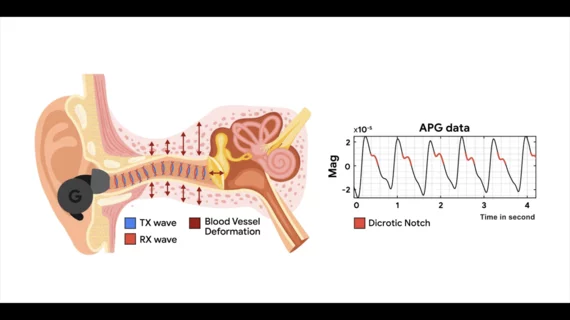Google researchers use noise-canceling headphones to monitor heart health
Researchers from Google have introduced a new approach for cardiac monitoring that relies on the active noise canceling (ANC) technology found in headphones and earbuds.
The technique, audioplethysmography (APG), can monitor a user’s heart rate and other physiological signals using ANC headphones—and it requires no additional sensors or battery power. A low intensity ultrasound transmitting wave is sent using the speakers placed inside the patient’s ear, and then it bounces back to be received by the on-board feedback microphones that provide the ANC technology.
This pulse-like wave synchronizes with the user’s heartbeat, the researchers explained.
“The auditory canal receives its blood supply from the arteria auricularis profunda, also known as the deep ear artery,” according to a blog post written by Google employees Xiaoran “Van” Fan and Trausti Thormundsson. “This artery forms an intricate network of smaller vessels that extensively permeate the auditory canal. Slight variations in blood vessel shape caused by the heartbeat (and blood pressure) can lead to subtle changes in the volume and pressure of the ear canals, making the ear canal an ideal location for health sensing.”
The two authors wrote that APG is quite resilient to motion artifacts, adheres to the necessary safety regulations and “inclusive of all skin tones.”
According to Fan and Thormundsson, scientists have been attempting to develop techniques for in-ear health monitoring for quite some time. This has proven to be a challenge, however, because adding electrocardiogram sensors or other features to ANC headphones leads to increases in costs, weight and power consumption.
Another key takeaway about this new modality is that it appears to work even with bad earbud seals or when music is playing. If the signal gets too noisy, however—like when the body is moving too much at once—it no longer provides much value from a clinical perspective.
Even with this limitation, however, early studies have associated APG with consistent heart rate and heart rate variability measurements. Researchers focused on data from two rounds of experiments that included 153 participants.
“APG represents new knowledge in biomedical and mobile research and unlocks new possibilities for low-cost health sensing,” Fan and Thormundsson wrote.
The team’s full analysis of APG can be read here. Google’s research team presented the findings at the Annual International Conference on Mobile Computing and Networking in Madrid, Spain, in early October.
Much more research is still needed, of course, before Google or any other company can consider bringing APG technology to market.

